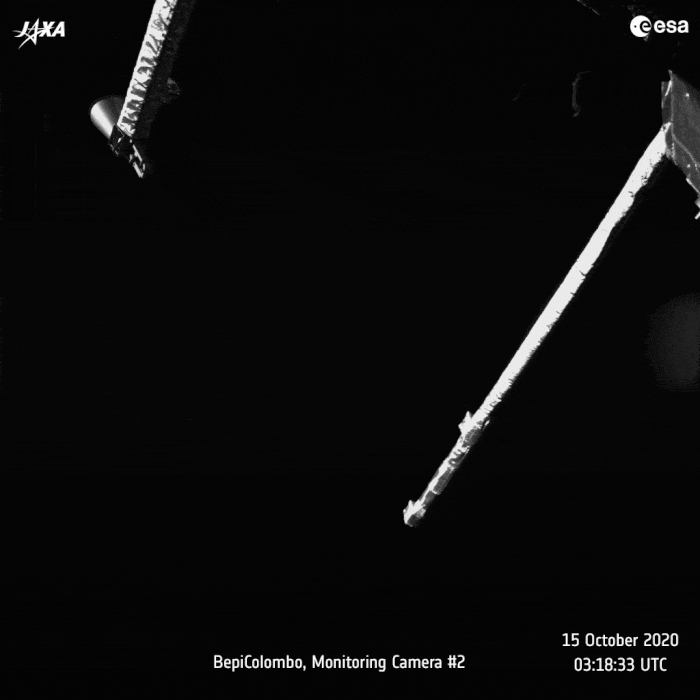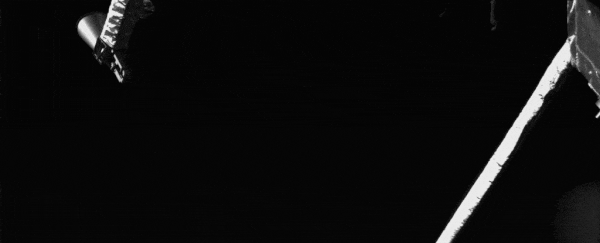Two years after it left Earth, Mercury probe BepiColombo has completed the first of its first flybys of Venus. The manoeuvre is designed to give the spacecraft a boost on its journey - but it's also too good an opportunity to pass up for a little science.
As it swung around the planet on a curved trajectory, BepiColombo gave its instruments a workout, testing their functionality for a taste of what the spacecraft will do in Mercury orbit and collecting some data on Venus – recently in the news for the discovery of phosphine gas in its atmosphere.
And the joint European Space Agency (ESA) and Japan Aerospace Exploration Agency (JAXA) probe took a whole lot of images, which the ESA compiled into a video of the flyby.
"This sequence of 64 images was captured by Monitoring Camera 2 onboard the Mercury Transfer Module from 40 minutes before until 15 minutes after closest approach of 10,720 kilometres (6,661 miles) from Venus," wrote the ESA in a blog post. "The images were taken every 52 seconds."
The images had to be slightly processed - Venus was so bright that the images are quite saturated, even with the shortest exposure times. But the shape of the terminator line, which marks the boundary between night and day, changes as BepiColombo moves around the planet in a curved trajectory.
 (ESA/BepiColombo/MTM)
(ESA/BepiColombo/MTM)
Gravity assist manoeuvres are a very common tool for moving spacecraft around the Solar System. They're also the work of very careful planning, with a route painstakingly mapped out in advance, with forward projection of where planets and moons are going to be when the spacecraft reaches them, in order to make the most of the encounters a voyaging spacecraft is going to have.
Basically, gravity assists use the gravity of a planet to aid the spacecraft in its journey, altering its trajectory and speed – either giving it a slingshot forwards, or helping it slow down. BepiColombo's journey involves nine gravity assists. The first involved Earth on April 10, earlier this year.
Venus was the second, taking place on October 15, using the planet's gravity to slow the spacecraft down without expending fuel. The third will also be Venus, in August 2021; the remaining six gravity assist flybys will be of Mercury itself, further slowing BepiColombo down so that it can finally arrive in a stable orbit in December 2025.
Both Venus flybys will be used to test BepiColombo instruments and collect Venus data. In this first flyby, scientists with the German Aerospace Center (DLR) and the University of Münster in Germany fired up the MErcury Radiometer and Thermal Infrared Spectrometer (MERTIS) instrument to take almost 100,000 images as BepiColombo approached the planet.
"During the Earth flyby, we studied the Moon, characterising MERTIS in flight for the first time under real experimental conditions. We achieved good results," said MERTIS project manager Gisbert Peter of the DLR Institute of Optical Sensor Systems.
"Now we are pointing MERTIS towards a planet for the first time. This will allow us to make comparisons with measurements taken prior to the launch of BepiColombo, to optimise operation and data processing, and to gain experience for the design of future experiments."
Venus and Mercury are quite different from one another - Mercury's a naked ball of dense rock and metal, and Venus is shrouded in a thick, toxic atmosphere that keeps the planet's surface temperature at scorching levels. MERTIS was designed to collect data on the rock composition of Mercury, but its infrared capabilities can also penetrate Venus' clouds to a certain depth.
MERTIS won't be able to detect the phosphine that so intrigued the world. But one theory about the phosphine was that it was created by volcanic activity. And recent evidence suggests that volcanic activity may be ongoing on Venus; this is something MERTIS can investigate.
"These [volcanoes] would be detected, for example, through the sulphur dioxide that they emit," said planetary scientist Jörn Helbert from the DLR Institute of Planetary Research.
"Following the first measurements made in the 1960s and 1970s, about ten years ago, ESA's Venus Express mission recorded a massive reduction, by more than half, of sulphur dioxide concentrations. Venus literally 'smells' of active volcanoes! MERTIS could now provide us with new information."
We won't have that information for a little while yet. The newly collected data will have to make its way down the processing and analysis pipeline. But it's so exciting, being on the cusp of a new era of Solar System science. And, although it's not BepiColombo's main mission, it's really exciting having a different, newer set of tools to poke into Venus' mysteries.
"We are already expecting some very interesting findings, with more to follow in 2021, when we will be much closer to Venus," said planetary scientist Harald Hiesinger of the University of Münster.
